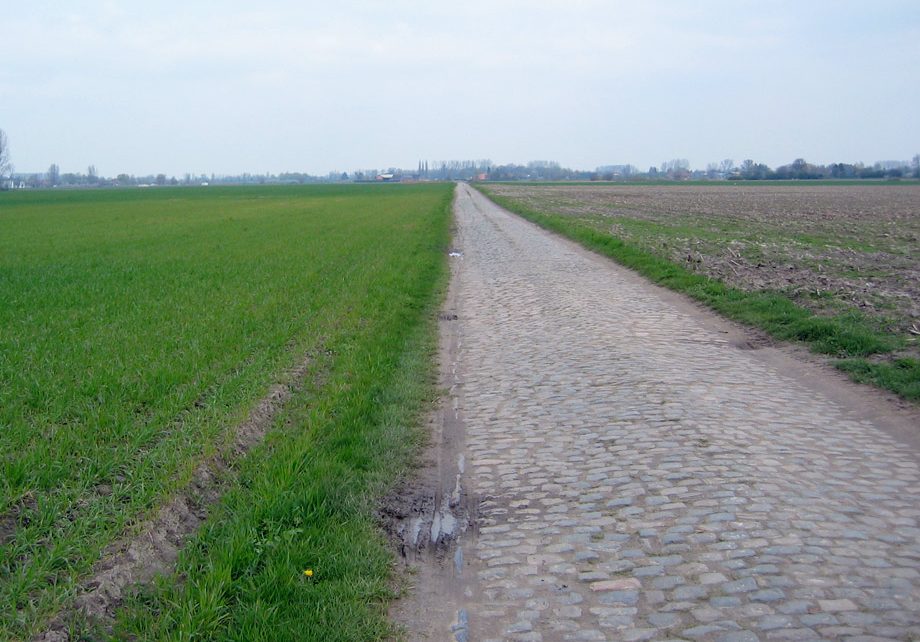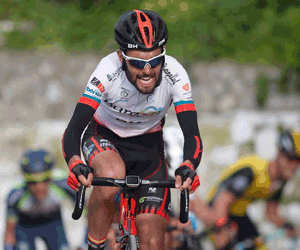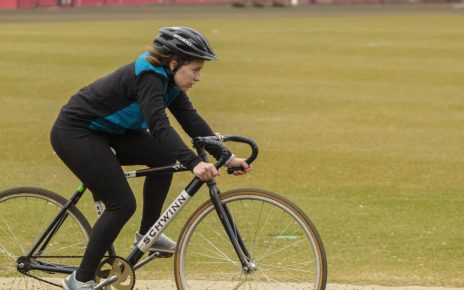PEZ-Fans: One of my favorite days of the year is that early Spring Sunday in April when Paris-Roubaix bashes across northern France. Most years I’m watching it at 5:00am with a hot cuppa Joe from PEZ HQ, but I’ve been lucky enough to see the race and ride the cobbles myself a couple of times. My first attempt was in 2004 – so I’ve reformatted the pics to fit our new site, and submit for your consideration my own first account of riding the pavé of Paris-Roubaix. – Pez
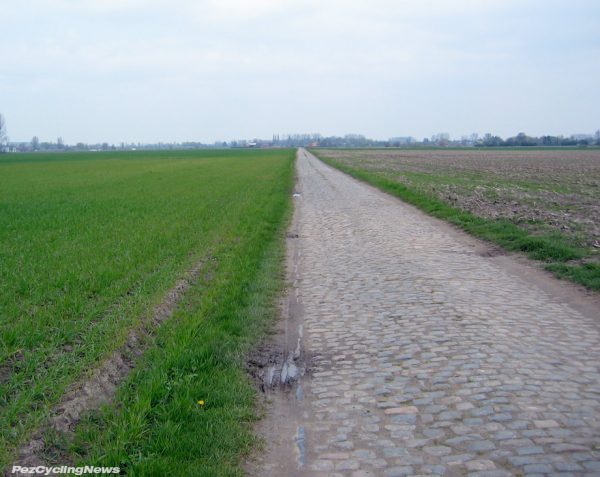 It was a day of historic – and epic – proportions. We’ve journeyed far, across continents, oceans, and the toughest roads in Europe, to arrive at the route for Sunday’s Hell of the North – Paris-Roubaix. Me and my butt found out first hand what it’s like to ride the “pavé”.
It was a day of historic – and epic – proportions. We’ve journeyed far, across continents, oceans, and the toughest roads in Europe, to arrive at the route for Sunday’s Hell of the North – Paris-Roubaix. Me and my butt found out first hand what it’s like to ride the “pavé”.
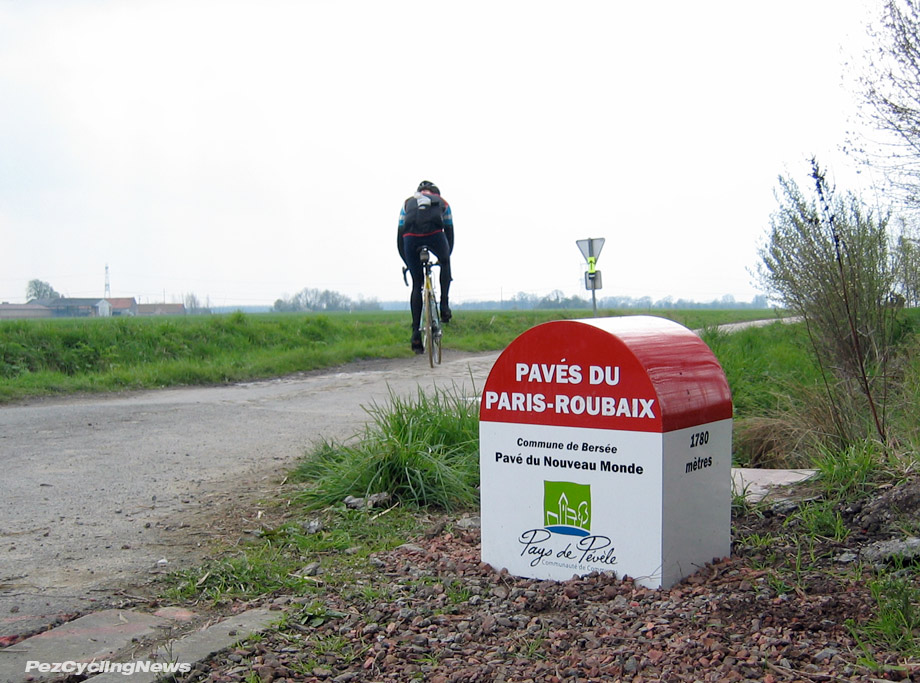
Historic sections of pave are marked by these posts, and protected as national monuments. The Arenberg Forest, for example, is only open to traffic one day of the year.
Friday was Day 9 of the Belgian Pez Spring Classics adventure, and after some of the nastiest, coldest, wettest weather I’ve seen, the day dawned bright and sunny. We were off to ride the second part of the Roubaix course, and were accustomed to heavy drenching rain during some part of any given ride – all I can say is thank God it did not rain today – as I now have even less interest in experiencing the pave in wet conditions…
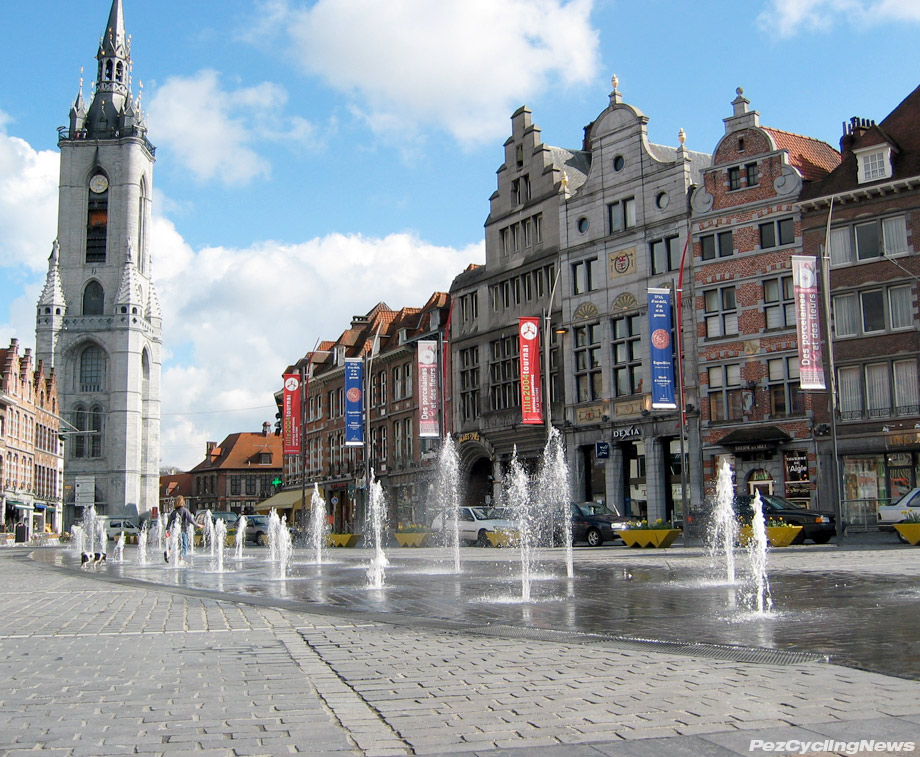 We had transferred about 1 hour south from Ghent, where Velo Classic Tours had set us up in yet another beautiful town – Tournai – for the next 3 nights. The Hotel d’Alcantara is themed after the great artists – Gauguin, Renoir, et al – and located just off the town square.
We had transferred about 1 hour south from Ghent, where Velo Classic Tours had set us up in yet another beautiful town – Tournai – for the next 3 nights. The Hotel d’Alcantara is themed after the great artists – Gauguin, Renoir, et al – and located just off the town square.
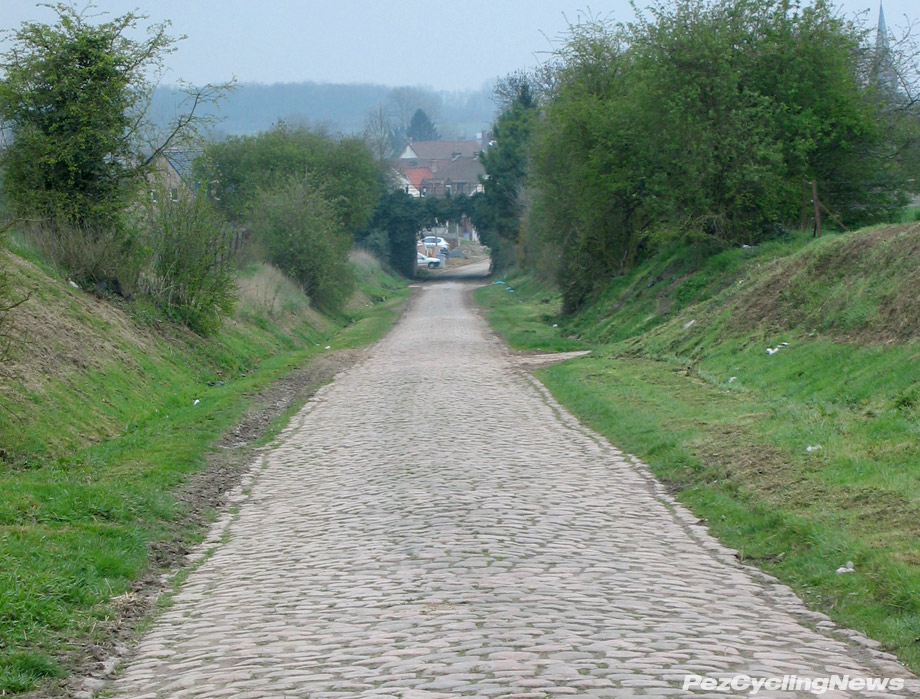
Looking back to the entry to Sector 17. There are 22 sectors of pave, numbered in descending order to the finish, covering about 50km.
PAVE´: Sector 17
As we drove to our ride start point, low cloud rolled in, adding an eeriness to our anticipation of what lay ahead. The temp was again cold – around 44F degrees (6C), but it was dry. After a short warm up on smooth paved roads, we turned hard right in the town of Haspres, dodged under a small rail bridge, and met Sector 17 – 1700 m cut through a field, slight climb to the mid-point, and then straight cross the potato fields that cover the countryside.
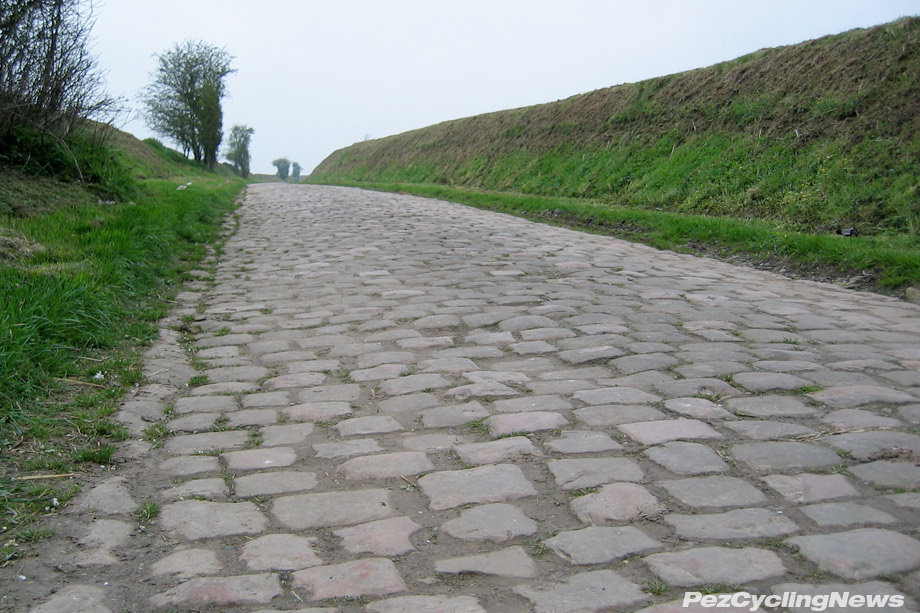
Everything is worse than you think when riding the cobbles of Roubaix. Not even a week in Flanders could prepare us for this…
We’d already ridden several kms of cobbles in the past week on the Flanders and Ghent-Wevelgem routes, but it was clear the cobbles of Roubaix are the worst by far. The stones are older, the paving less uniform, the edges sharper. The cobbled sections are just tiny and ancient farm paths that cut across fields, beside people’s houses, and in one case what appeared to be down an alley.
It’s clear which sectors are the oldest by the humped ridge that runs along the center of the track. In some cases the slope is so steep that the one false move and you lose your track across the top and just plummet to the gutter. Usually every line around you looks better than the one you’re on, until you change lines and realize it’s actually worse.
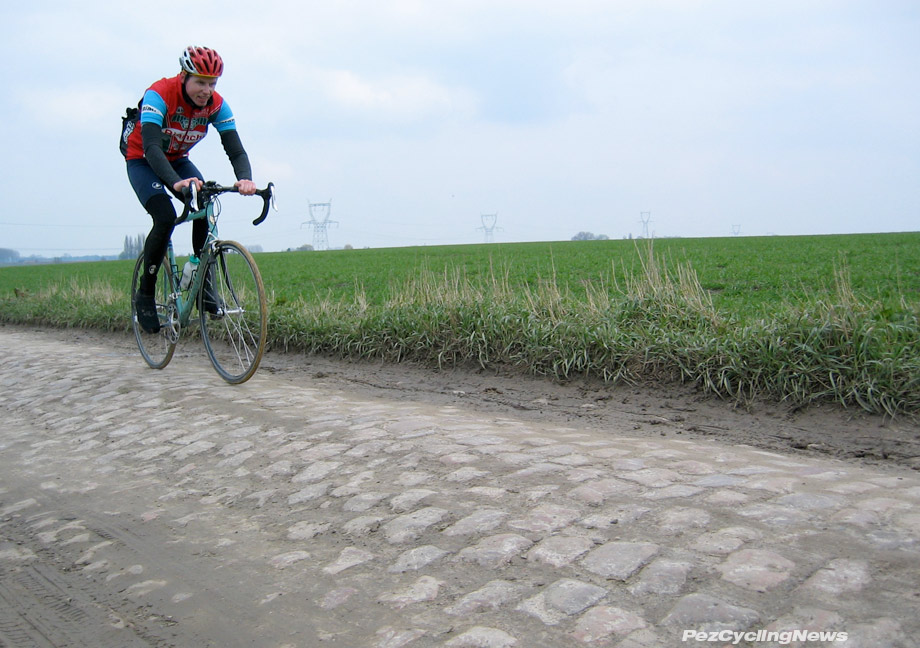
PAVE´ – How Do You Ride This Stuff?
There’s no easing into the pave, no dipping your toe to test the water… fuggettaboutit. And the slower you go the worse it is. You must attack the cobbles!!! Experts say to ride the biggest gear possible, and use your speed to carry you across the tops of the stones – the pain is worse when you roll into the cracks and grooves between each stone and take the full jolt of unyielding French stone smacking its way through your bike to you.
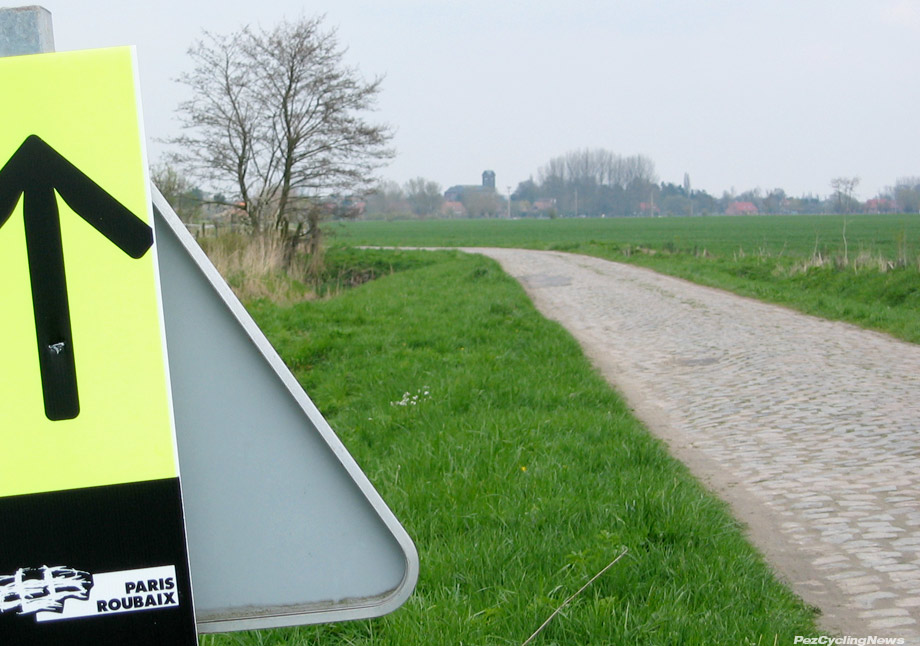 Which raises another problem… holding on. It’s two hands or nothing. You gotta hold on for dear life, because your once softly padded gel-tape is immediately transformed into what feels like sharply knobbled lead pipe that someone keeps smashing against your hands. Sure it’s like a jackhammer, but it’s worse… way worse. It took me about 1500 meters to wish I was riding dual suspension. And there is no escaping the harsh pounding you take. A rigid bike is a rigid bike – and your poor ass is what absorbs all the shock.
Which raises another problem… holding on. It’s two hands or nothing. You gotta hold on for dear life, because your once softly padded gel-tape is immediately transformed into what feels like sharply knobbled lead pipe that someone keeps smashing against your hands. Sure it’s like a jackhammer, but it’s worse… way worse. It took me about 1500 meters to wish I was riding dual suspension. And there is no escaping the harsh pounding you take. A rigid bike is a rigid bike – and your poor ass is what absorbs all the shock.
The best position I found was to hold the bar tops in the center, push my self back, and let the bike go where it wants. Keep pedaling and it will track straight, but hesitate and you’re in for it…
Next Up – ARENBERG FOREST
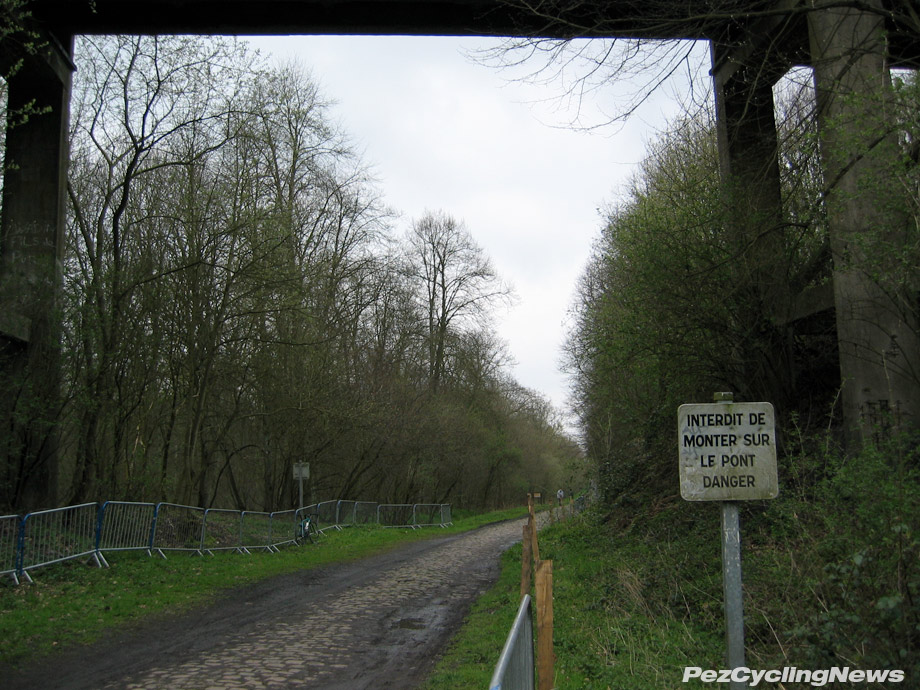
Into the fabled Arenberg Forest: dead straight, 2400 meters long, gradual dip to the middle. It’s dark in here. The cobbles are different from other sectors – they’re sharper and further apart. But what really makes it interesting is the wet – I almost went down a few times as I plodded and picked my way slowly through from one side to the other. More than a little luck is needed to get through here…
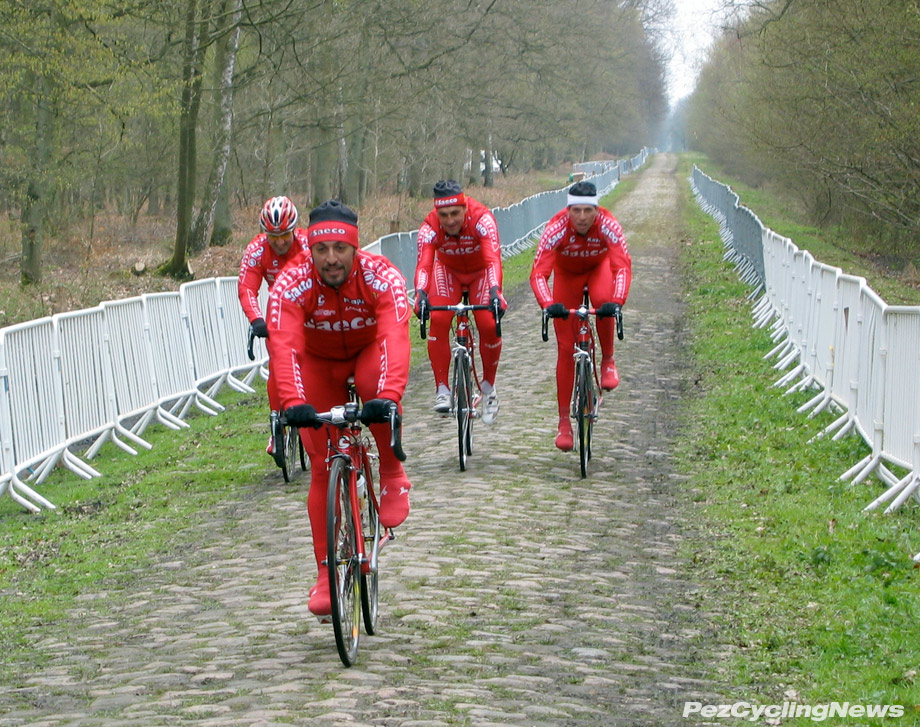
The Saeco boys emerge from Arenberg. We bumped into Salvatore Commesso and co, astride a variety of shiny Cannondales featuring headshocks, cross set-ups, v- and cantilever brakes. Then we joined ‘em for a few kms and a couple sections of cobbles.
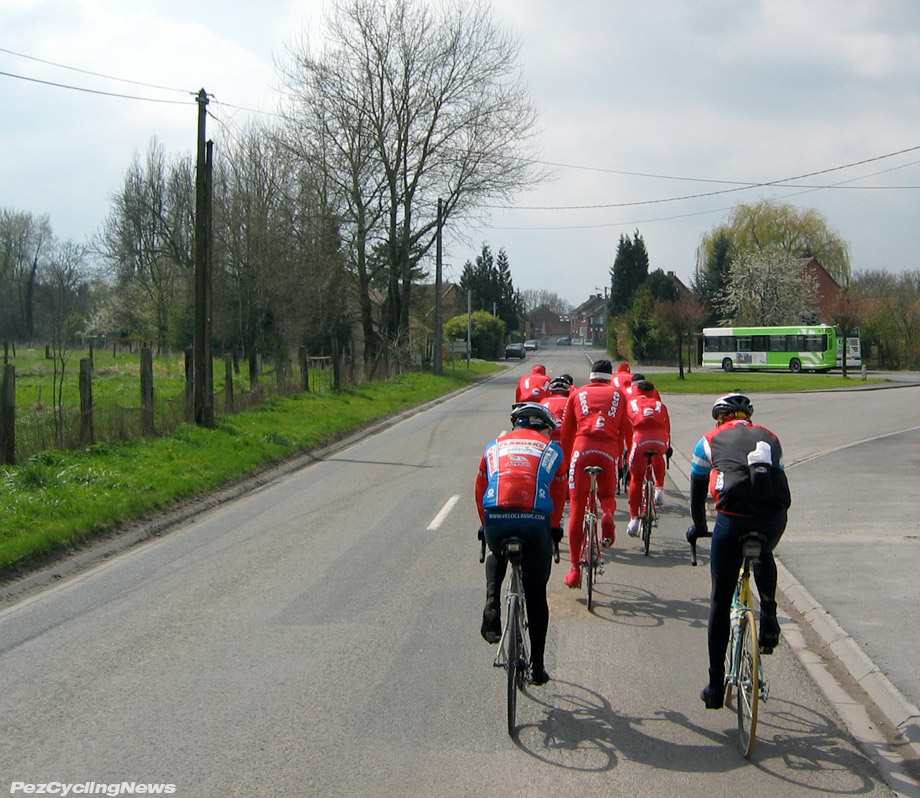 We stayed politely at the back of their group, rolling along a warm-up pace. We laughed knowing they could drop us at will, and thrilled that they hadn’t… yet. Then we hit the 1 km long Sector 14 at Wallers. It wasn’t like they so much turned up the pace, as simply held the pace we were riding on the road. Problem for us punters though, was having to notch-up our own game to hold that pace on the pave.
We stayed politely at the back of their group, rolling along a warm-up pace. We laughed knowing they could drop us at will, and thrilled that they hadn’t… yet. Then we hit the 1 km long Sector 14 at Wallers. It wasn’t like they so much turned up the pace, as simply held the pace we were riding on the road. Problem for us punters though, was having to notch-up our own game to hold that pace on the pave.
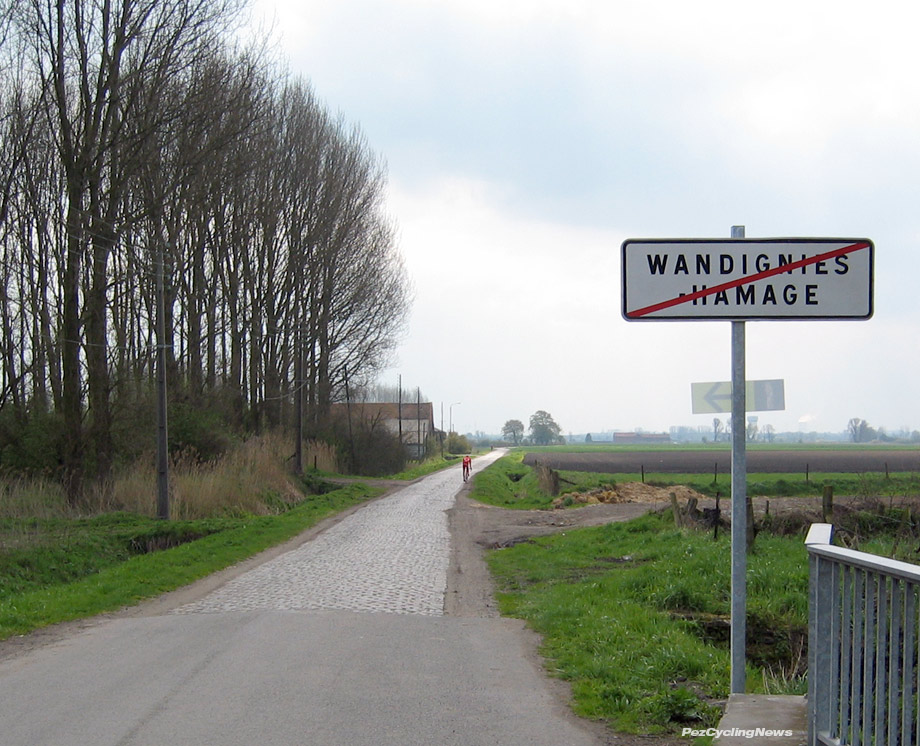 Of course we fell back, but caught back on before Sector 13 – an endless, punishing and demoralizing 3700 meters. I decided to give it a go and shoved my Dura-Ace 10 speed into the 53… I hoped for the best. Our little group of chasers dropped off one by one, accepting that survival here is a noble accomplishment. I finally hit my own wall, and watched as the Red Train rolled away across the French field.
Of course we fell back, but caught back on before Sector 13 – an endless, punishing and demoralizing 3700 meters. I decided to give it a go and shoved my Dura-Ace 10 speed into the 53… I hoped for the best. Our little group of chasers dropped off one by one, accepting that survival here is a noble accomplishment. I finally hit my own wall, and watched as the Red Train rolled away across the French field.
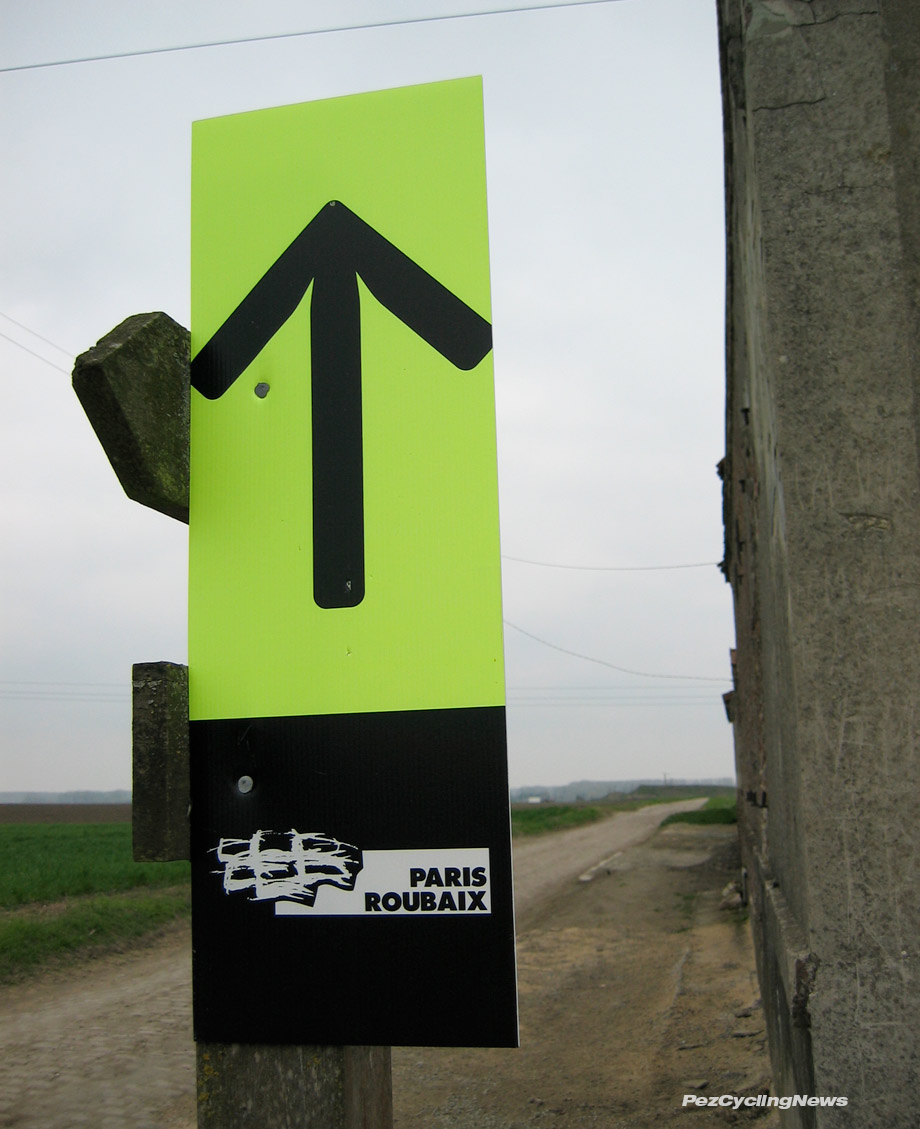 So here I am, heart rate in the stratos, arms, hand, legs and feet aching from the bashing, my world closes in and becomes a focus of 6 ft ahead – looking for that line that is just a tiny bit smoother… Bashing on I go. Then … up ahead I see one, then another red suit riding alone. Hmmm… this can only mean one thing… they’re suffering too! One of the Saeco boys turns around and rides back past me… his face showing complete disgust. He’s not a happy camper and I wonder how long before he packs it on Sunday.
So here I am, heart rate in the stratos, arms, hand, legs and feet aching from the bashing, my world closes in and becomes a focus of 6 ft ahead – looking for that line that is just a tiny bit smoother… Bashing on I go. Then … up ahead I see one, then another red suit riding alone. Hmmm… this can only mean one thing… they’re suffering too! One of the Saeco boys turns around and rides back past me… his face showing complete disgust. He’s not a happy camper and I wonder how long before he packs it on Sunday.
I feel a tiny piece of satisfaction as I roll on smooth roads again to Sector 12.
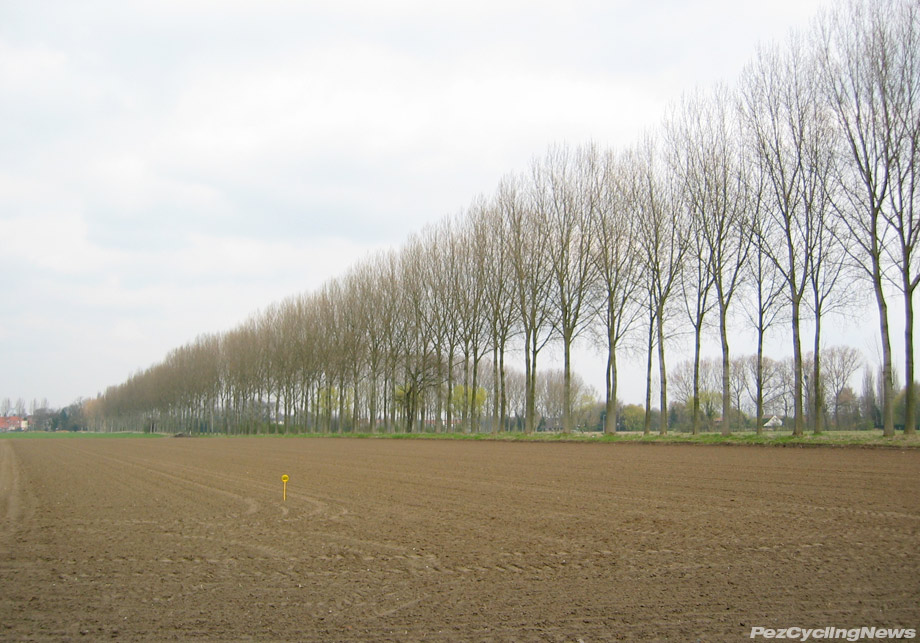 This far I’ve covered only 5 sectors of cobbles, for about 11km, and I am feeling it. The legs aren’t recovering like they should, it takes longer to shake the feeling back into my arms and hands… I sense a turning point for Pez.
This far I’ve covered only 5 sectors of cobbles, for about 11km, and I am feeling it. The legs aren’t recovering like they should, it takes longer to shake the feeling back into my arms and hands… I sense a turning point for Pez.
The JOY OF LUNCH
After struggling on alone through Sectors 12 & 11, I came upon the much-welcomed lunch stop. There was Lisa from Velo Classic, smiling beside a picnic feast set up and waiting. Belgian breads and pastries, cheeses, sausages, prosciutto, yoghurt, fruit, chocolate… absolutely the right thing to do!
We’d already covered about 65km, and some of the group wisely decided to enjoy the rest of the day from the warmth of the van. But not me…
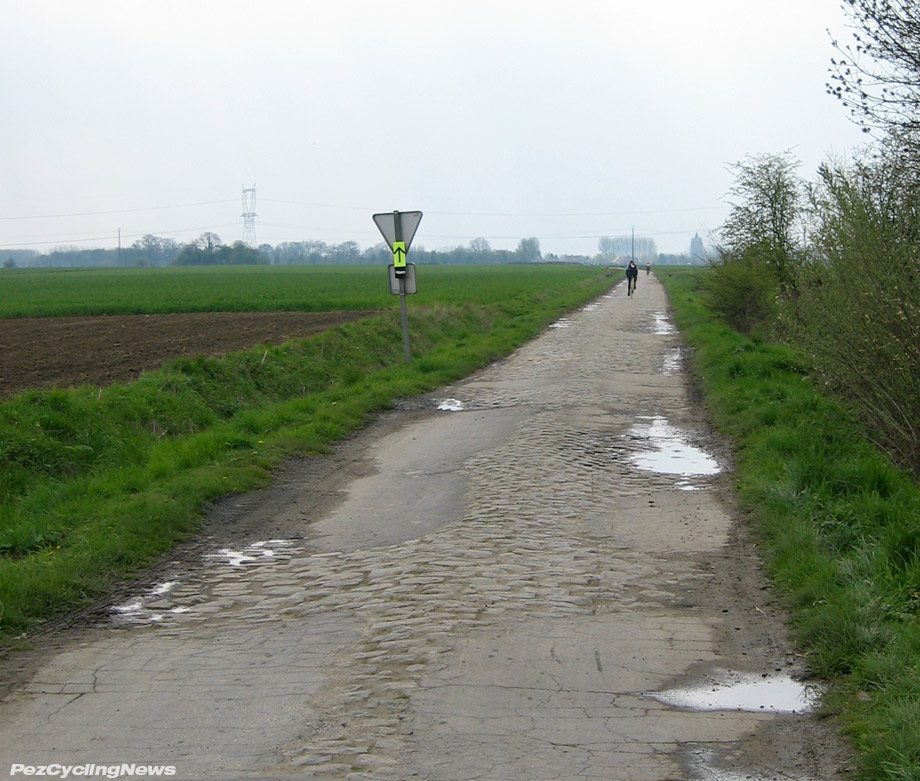 My legs were pretty much done, and after the next sector of cobbles, I realized the rest of me was also shot. I was now fully in “epic” mode, and riding to get to the end, which came about 40km and 5 more sectors of cobbles later. I was still about 20km shy of the Roubaix Velodrome, but was thoroughly satisfied with the ride.
My legs were pretty much done, and after the next sector of cobbles, I realized the rest of me was also shot. I was now fully in “epic” mode, and riding to get to the end, which came about 40km and 5 more sectors of cobbles later. I was still about 20km shy of the Roubaix Velodrome, but was thoroughly satisfied with the ride.
I feel like I have an actual understanding of what this race is about, and what kind of riders do well here. To me, this race seems harder than Flanders, because the cobbles seem more frequent, get worse, and stay worse.
Paris-Roubaix is a race built for only the toughest of the tough. Having ridden these roads, I at least know what they feel like rolling and smashing under my own wheels. This is riding in the birthplace of our sport, and something you should all do – trust me – it will be well worth the pain.
The Co-Motion RISTRETTO Meets Roubaix.
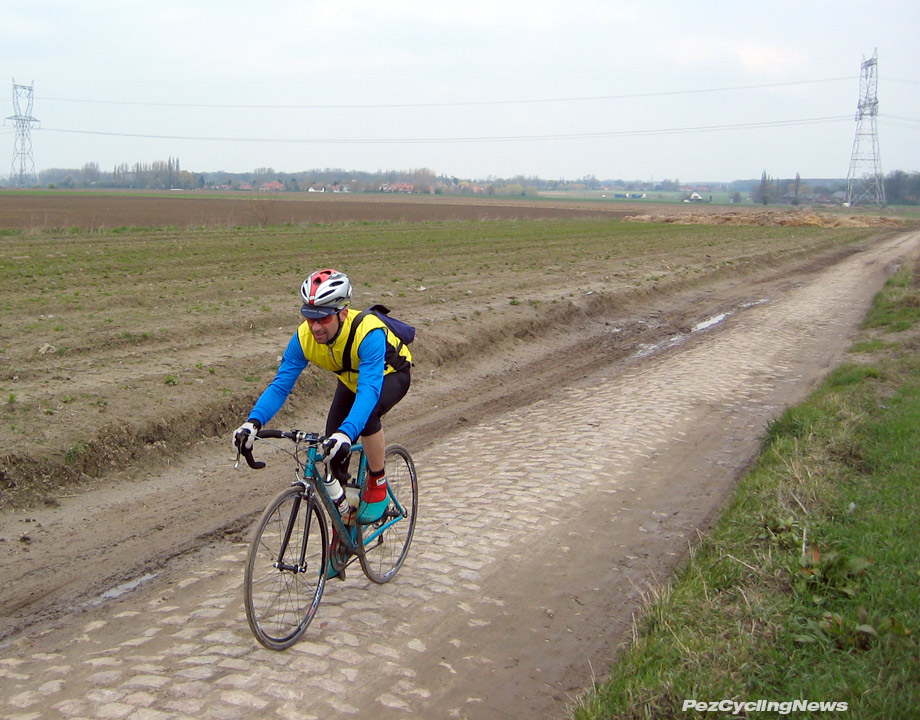 You hope your trusty steed doesn’t self destruct like the clown car at the smash-up derby. The only sound louder than your own cursing, is the cursing your bike gives you. Pings, pangs, groans, creaks, squeals squeaks and shrieks… seriously it’s enough to make you want to put your ride out of it’s misery, and then do yourself the same favour. After all that, the Co-Motion Ristretto emerged rock solid. The Rolf wheels held fast, and even though I half expected to lose a spoke or two, they are as tight and true as when we started.
You hope your trusty steed doesn’t self destruct like the clown car at the smash-up derby. The only sound louder than your own cursing, is the cursing your bike gives you. Pings, pangs, groans, creaks, squeals squeaks and shrieks… seriously it’s enough to make you want to put your ride out of it’s misery, and then do yourself the same favour. After all that, the Co-Motion Ristretto emerged rock solid. The Rolf wheels held fast, and even though I half expected to lose a spoke or two, they are as tight and true as when we started.
This was a tough week in extreme conditions of wind, rain, mud, cobbles, and the Ristretto weathered them all. Honestly, I fully expected something to fall off, break, come loose… even chip. But it hasn’t happened. Dwan Shepard and the guys build a tough bike, and although aluminum is not my first choice to hammer over the pave, there’s a lot to be said for riding a bike that you can trust to get you home from wherever you go.
In the next couple of weeks we’ll put the Ristretto through the rest of its paces (can’t wait to go uphill on this baby) and get back to you with the full review.
GET MORE KNOWLEDGE:
Check out the websites for
Velo Classic Tours
